Introduction
According to the National Climate Report in 2020, the contiguous United States’ average annual precipitation measured 30.28 inches, which was slightly above past averages. States that see lower-than-average annual precipitation make up much of the West, including Nevada, Utah, Colorado, Arizona, and more. Drought in the western United States has troubled officials and residents in this region and has led to crises like the drying up of the Great Salt Lake and Lake Mead. On the other hand, the eastern portion of the country experiences much more annual rainfall. In fact, most of the wettest states in the nation are located in the Southeast. Discover the top ten rainiest states in the U.S. and find out which state is the wettest in the nation.

The 10 Rainiest States in the United States
States that experience an average amount of annual precipitation include much of the Northeast and other states such as Texas or Indiana. By far, though, the rainiest region of the United States is the Southeast. Nearly every state in the Southeast experiences rainfall far above the averages that define the remainder of the continental 48 states. Below are the top 10 rainiest states in the U.S., from the least amount of annual precipitation to the most amount of yearly rainfall.
1. South Carolina

South Carolina is the tenth rainiest state in the U.S., receiving around 48.0 inches of rainfall per year.
©Brian A Jackson/Shutterstock.com
This state borders the Atlantic Ocean and other states like North Carolina and Georgia. The climate in this state is considered subtropical, with hot summers and mild winters. During July, the state sees temperature averages between 70ºF and 80ºF. Winter brings cooler average temperatures that range between 38ºF to 50ºF.
South Carolina is the tenth rainiest state in the U.S., receiving around 48.0 inches of rainfall per year. The state averages 3.9 inches of rainfall per month, and its rainiest month is August. The wettest location in the state is Jocassee, South Carolina, which receives an average of 84.38 inches of precipitation per year. The driest location is McColl, South Carolina, with 39.04 inches of annual precipitation.
Plant and animal life in South Carolina varies according to the region. Some trees commonly found in the state include pine, magnolia, and cypress trees. Spanish moss often covers magnolia trees near the Coastal Plain. Wildlife in South Carolina includes a diverse assortment of mammals, birds, reptiles, and more. The white-tail deer is the most common mammal in this state, alongside wild turkey and beaver populations. The state features over 300 bird species, too. On the Coastal Plain, people can find formidable creatures like alligators and venomous snake species.
2. North Carolina
North Carolina, like South Carolina, borders the Atlantic Ocean on the East Coast. The state of North Carolina averages 49.3 inches of rainfall annually, making it the ninth rainiest state in the U.S. The rainiest month of the year for North Carolina is August, and the state sees an average of 4.0 inches of rainfall per month.
The wettest location in the state is Lake Toxaway, North Carolina, which receives an average of 91.72 inches of precipitation per year. The driest location is Asheville, North Carolina, with 37.32 inches of annual precipitation. The climate in North Carolina is continental throughout most of the state. Summers are cooler than that of the neighboring South Carolina, with average yearly temperatures measuring between 55ºF and 66ºF.
North Carolina is divided into three primary regions; plant and animal life varies according to these divisions. For instance, mountainous areas in this state will feature tree species like red spruce and balsam fir. On the other hand, portions of the state that experiences a warmer, more humid climate will contain Venus flytrap and subtropical palmetto. Rabbits, deer, bears, and more are mammals found frequently in North Carolina. Bird species include cardinals, woodpeckers, and chickadees, to name a few. Bass and sunfish are examples of freshwater fish in the region.
3. Arkansas
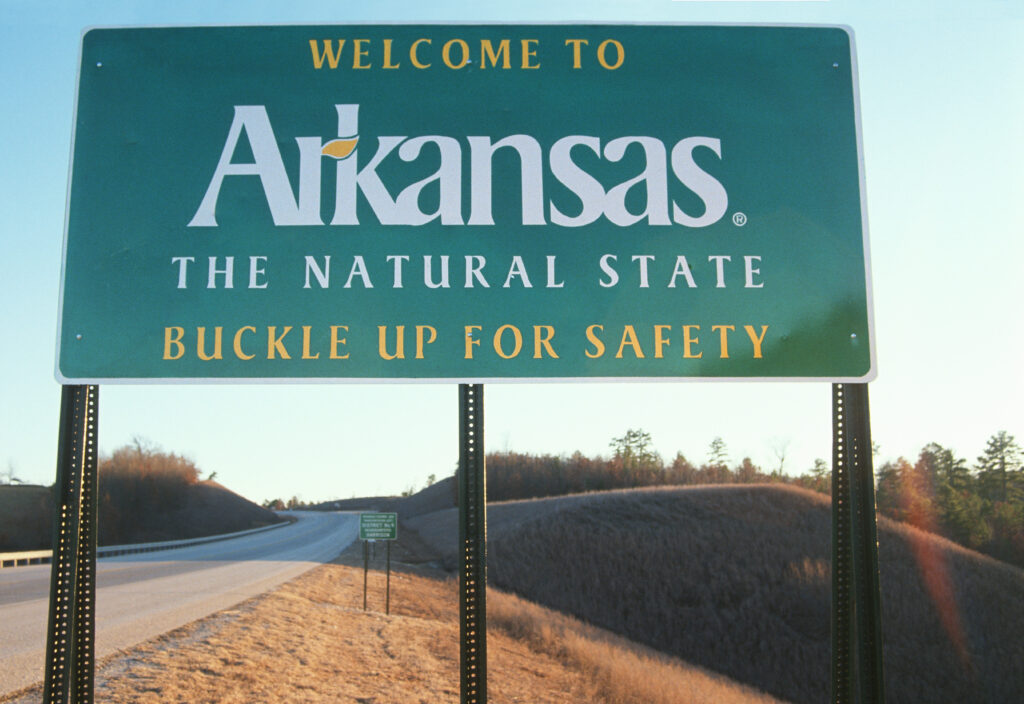
Arkansas lies just West of the Mississippi in the southern
United States
.
©Joseph Sohm/Shutterstock.com
Arkansas is the eighth rainiest state in the U.S., with annual rainfall measuring approximately 49.6 inches. The monthly rainfall averages 4.0 inches, and the rainiest month of the year for the state is May. The wettest location in the state is Big Fork, Arkansas, which receives an average of 62.65 inches of precipitation per year. The driest location is Omaha, Arkansas, with 40.40 inches of annual precipitation.
This state lies just West of the Mississippi in the southern United States. This state borders a plethora of other states, including Texas, Tennessee, and Oklahoma. The climate in Arkansas mirrors that of the rest of the Southeast, with mild winters and hot summers. The month of January sees average temperatures between 30ºF and 50ºF, while July experiences temperatures ranging between 70ºF and 90ºF on average.
Vegetation in the state of Arkansas includes tree species like oak and hickory. Expansive forested areas and geographical features like the Ozark Mountains dominate the state. The lowlands of Arkansas are mainly used for farming, but nearly 50% of the land in Arkansas is forested. Approximately 300 bird species reside in this state. Waterfowl in Arkansas include geese and ducks, and some mammals in the region are squirrels, opossums, and deer. Many people visit the Ozarks in Arkansas to fish for its diverse aquatic life, including trout, walleye, crappie, and more.
4. Georgia

Georgia is a beautiful state by any standard of the imagination.
©Sue Smith/Shutterstock.com
Georgia resides in the southeastern region of the United States, bordering Tennessee, South Carolina, Alabama, and more. The climate in the state can range from tropical to continental, depending on the season. Temperatures averages also vary in this state. For instance, average winter temperatures in Atlanta, Georgia, measure 42ºF. By comparison, cities further south see temperature averages 10ºF higher than that of January’s averages in Atlanta.
Annual rainfall averages for the state of Georgia measure around 50.1 inches. Monthly rainfall in the state sits at 3.9 inches, with the wettest month being July. Georgia ranks number seven on the list of rainiest states in the country. The wettest location in the state is Clayton, Georgia, which receives an average of 73.36 inches of precipitation per year. The driest location is Mount Vernon, Georgia, with 40.49 inches of annual precipitation.
The state of Georgia includes many topographical features, such as mountains and beaches. Thus, the plant and animal life in this state is diverse and can vary. Examples of trees in Georgia are maples, birches, pine, and oak. Animals like alligators dominate the southern portion of the state, while the mountainous regions see mammals like bears and deer. Sea turtles are present along the coast, and rabbits, raccoons, and turkeys can be found near forests or meadows. The most prominent fish species in Georgia can be encountered either in the state’s freshwater lakes and rivers or along the coast.
5. Tennessee
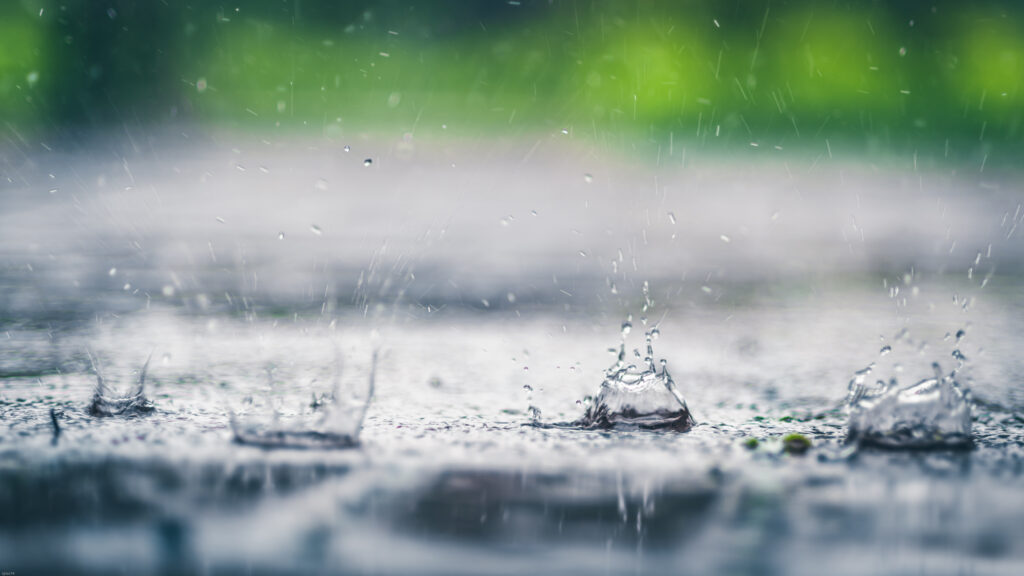
The climate in Tennessee is moderate, with summer temperature highs averaging in the 80s and winter highs averaging around 45ºF.
©Jia Ning Chen/Shutterstock.com
Like Georgia, Tennessee’s rainiest month occurs during July. However, Tennessee has a higher monthly rainfall average than Georgia at 4.1 inches. The annual average rainfall for the state of Tennessee measures 51.6 inches, making it the sixth wettest state in the nation. The wettest location in the state is Mount Leconte, Tennessee, which receives an average of 81.28 inches of precipitation per year. The driest location is Bristol, Tennessee, with 41.33 inches of annual precipitation. Tennessee borders states like Kentucky and Alabama, and it resides in the upper part of the South. The climate in Tennessee is moderate, with summer temperature highs averaging in the 80s and winter highs averaging around 45ºF.
Approximately 50% of the state is covered in dense forests, much like the state of Arkansas. Within these forested areas are tree species like poplar, maple, elm, and walnut. Some native wildlife in Tennessee includes foxes, skunks, and coyotes. Tennessee also includes an abundance of amphibians and reptiles, such as snakes and frogs. Waterfowl common to the region are herons, geese, ducks, and shorebirds. Fish that swim in Tennessee streams and lakes include catfish, perch, and various kinds of minnows.
6. Florida
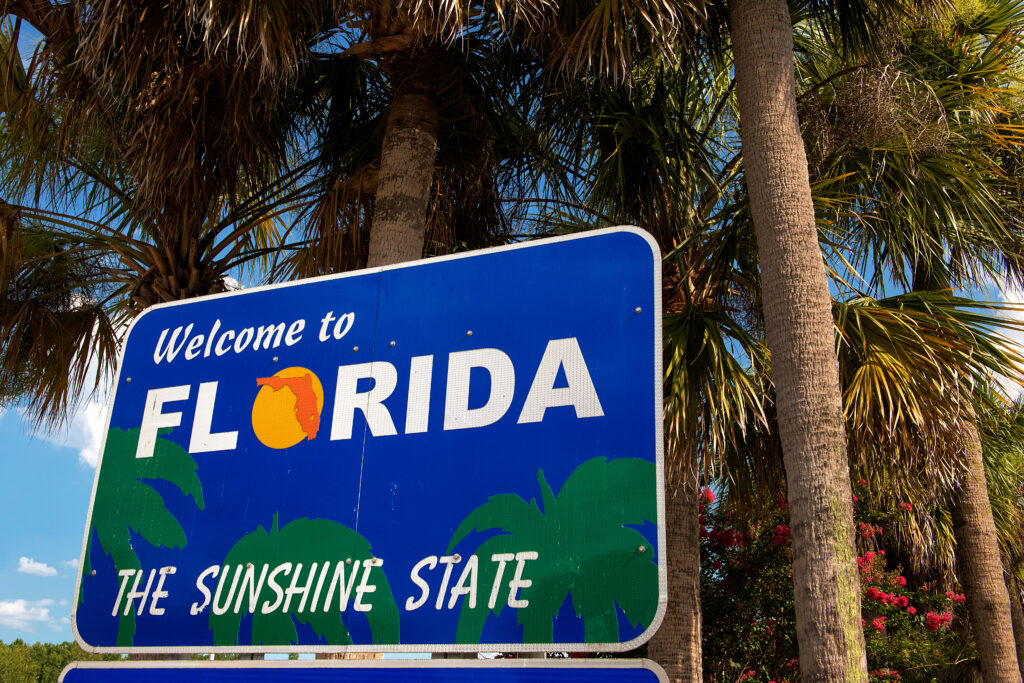
©Ingo70/Shutterstock.com
Florida is the most southern state in the southeast and has the largest population in the region. The state is a peninsula that sticks out into the Atlantic Ocean, with the Gulf of Mexico bordering its western side. Florida sees 53.7 inches of rainfall per year and 4.5 inches of rainfall per month. Florida’s wettest month of the year is August. The state of Florida ranks number five on the list of the rainiest states in the United States.
The wettest location in the state is Pensacola, Florida, which receives an average of 52.30 inches of precipitation per year. The driest location is Key West, Florida, with 38.94 inches of annual precipitation. Known as the “sunshine state,” Florida has a tropical and subtropical climate. The state has hot summers and rarely experiences freezing temperatures, especially in the southernmost portion.
Plant and animal life in this state is extremely abundant, which is part of the state’s appeal. Thousands of plant species exist in Florida, including mangroves, palms, and magnolias. Wildlife is unique to the region, as Florida is positioned so far South. Some incredible animals in the state are manatees, crocodiles, and pumas. Over 400 species of birds live in Florida, such as eagles, pelicans, and ibises. The most prominent animal in this state is the alligator, as alligator populations in the United States record their greatest number in Florida.
7. Alabama
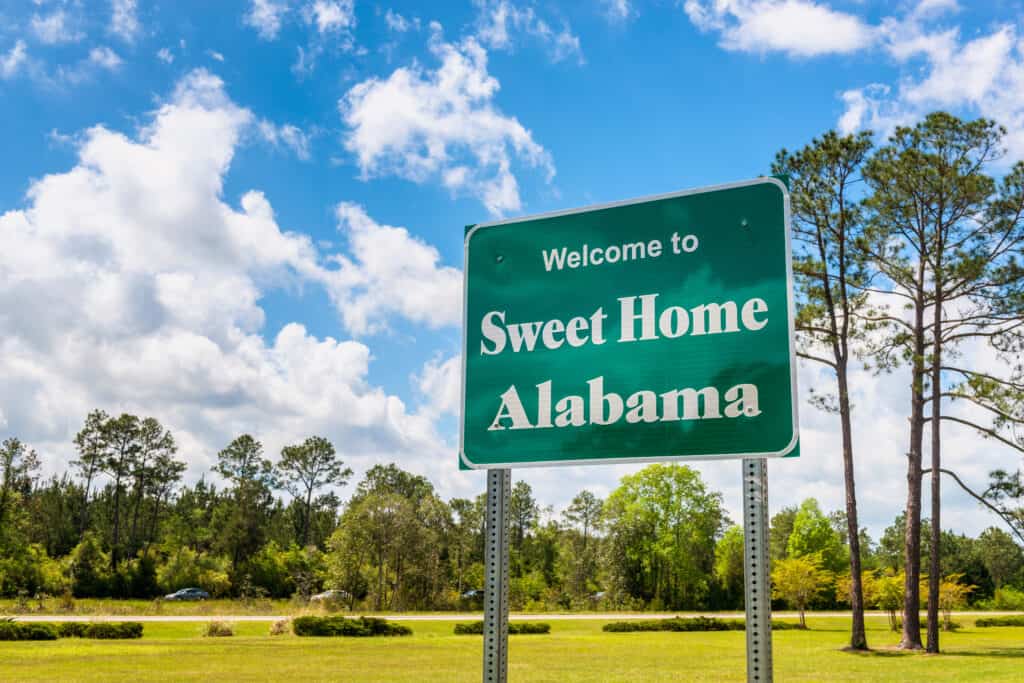
The climate in Alabama is temperate, but the state sees higher temperatures during the summer months.
©Allard One/Shutterstock.com
Alabama is the fourth rainiest state in the country, with annual average rainfall totals measuring 55.3 inches. The rainiest month of the year for Alabama occurs in March, and the monthly average rainfall in the state is 4.7 inches. The wettest location in the state is Robertsdale, Alabama, which receives an average of 67.31 inches of precipitation per year. The driest location is Montgomery, Alabama, with 48.36 inches of annual precipitation.
Alabama sits just north of the Gulf of Mexico and borders Tennessee, Georgia, Mississippi, and the Florida panhandle. The climate in Alabama is temperate, but the state sees higher temperatures during the summer months. Summer temperatures can exceed 100ºF but mainly reside around 79ºF. Average winter temperatures measure 48ºF in Alabama.
The most common tree species in Alabama are pine and oak trees. However, sweet gum and black walnut trees can also be found. The state features a variety of birds, including bluejays, mockingbirds, hawks, and doves. Mammals include raccoons, bobcats, and the occasional coyote or bear. Both venomous and non-venomous snakes dominate the area, with species like copperheads, rattlesnakes, and black snakes. In some coastal portions of Alabama, one might find an alligator or two.
8. Mississippi

Mississippi has an average summer temperature of 60-90 degrees Fahrenheit.
©iStock.com/Andrey Semenov
Mississippi borders Alabama, Tennessee, the Gulf of Mexico, and some other southern states. The climate in Mississippi is characterized by warm summers and mild winters. Average temperatures during summer months range from the upper 60s to 90ºF. Winters see temperatures between 30ºF and the mid-50s.
The state of Mississippi experiences 55.5 inches of rainfall every year on average. The state also sees around 4.6 inches of rainfall per month. The wettest month of the year for Mississippi is December, and the state ranks third on the list of the rainiest states in the U.S. The wettest location in the state is Vancleave, Mississippi, which receives an average of 72.10 inches of precipitation per year. The driest location is Cleveland, Mississippi, with 50.97 inches of annual precipitation.
In the southern areas of Mississippi, tree species like oaks and pines are common. On the other hand, the North Mississippi has hickory trees. Magnolia and pecan trees can be found all over the state, and over half of Mississippi’s land mass is covered by forests. Deer and wild turkeys have large populations in this state, while bobcats and bears are rare finds. Woodpeckers, hummingbirds, and bald eagles are examples of bird species that migrate to or reside in Mississippi. Freshwater fish include perch, catfish, and bass, while aquatic life along the coast takes form in shrimp, saltwater fish, and oysters.
9. Louisiana
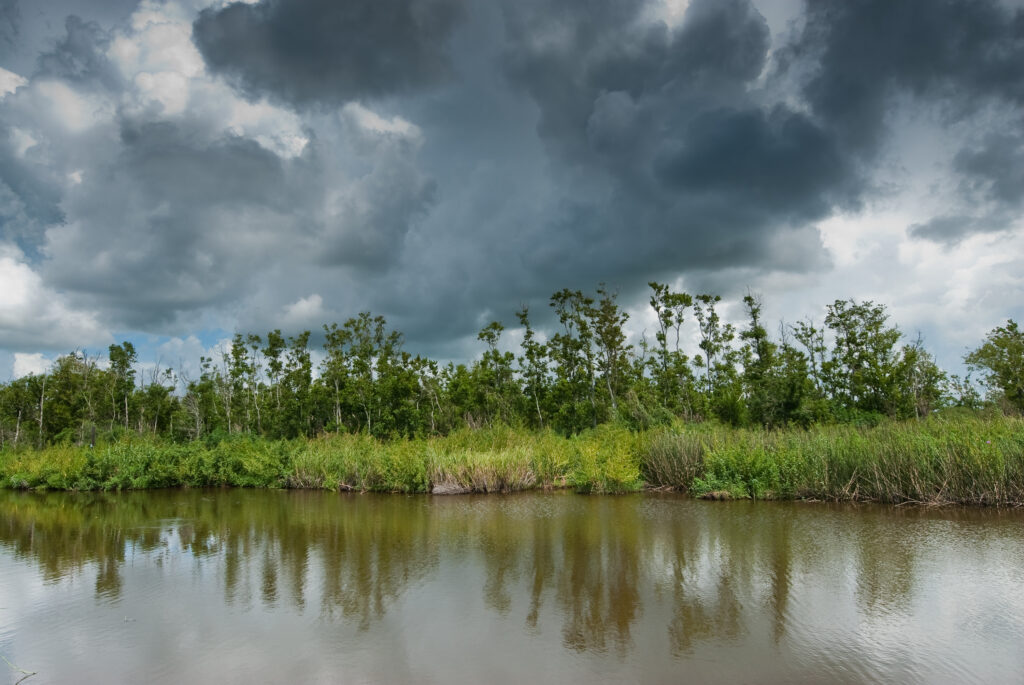
Due to Louisiana’s proximity to the Gulf of Mexico, Louisiana’s climate is considered subtropical.
©Peter Wey/Shutterstock.com
Louisiana is the second wettest state in the U.S., with annual rainfall averages laying around 56.9 inches. The average monthly rainfall for the state of Louisiana is 4.8 inches, and the wettest month of the year in this state is June. The wettest location in the state is Thibodaux, Louisiana, which receives an average of 69.95 inches of precipitation per year. The driest location is Red River Lock, Louisiana, with 46.46 inches of annual precipitation.
Louisiana is one of the southernmost states in the country, bordering the Gulf of Mexico, Mississippi, Texas, and Arkansas. Due to its proximity to the Gulf of Mexico, Louisiana’s climate is considered subtropical. Average yearly temperatures in Louisiana measure 64ºF and 71ºF in the north and south, respectively.
Like North Carolina, Louisiana’s vegetation and wildlife vary according to three regions. Pines and bald cypress are found in the first region, while the second region is mainly comprised of grasslands and prairies. In Louisiana’s third region, one can find magnolia trees and Spanish moss. Alligators and muskrats are examples of wildlife found in South Louisiana marshes. Birds include many species, like the brown pelican, which is now endangered. Deer and squirrels are prevalent in this state, and common aquatic life includes shrimp, crayfish, and crabs.
10. Hawaii
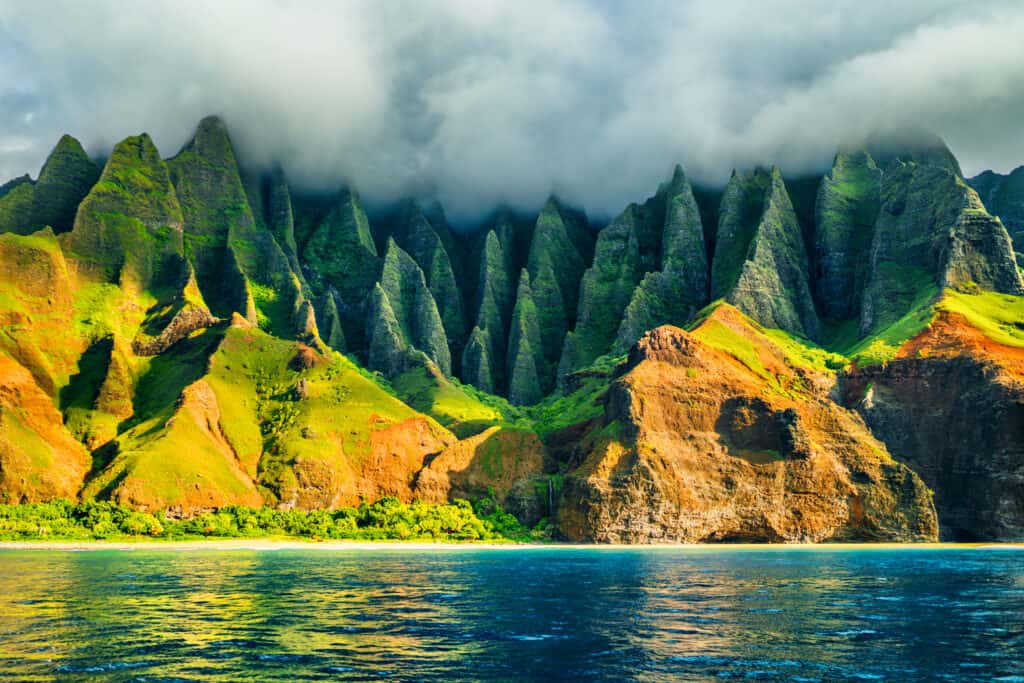
Hawaii gets around 57 inches of rain per year.
©Maridav/Shutterstock.com
Hawaii was introduced as the 50th state of the United States in 1959. Unlike most states in the country, Hawaii lies outside of the North American continent. Rather, the state is a grouping of islands in the Pacific Ocean. Similar to Louisiana, Hawaii averages 4.8 inches of rainfall per month. Over the course of the year, though, the state averages 57.2 inches of annual rainfall, making it the rainiest state in the nation.
The wettest month of the year in Hawaii is December. The wettest location in the state is Mount Waialeale, Hawaii, which receives an impressive average of 460 inches of precipitation per year. The driest location is Puako, Hawaii, with 5.7 inches of annual precipitation. The climate in Hawaii is tropical and humid. Hawaii’s climate is also dominated by the summer and winter seasons; most Hawaiians don’t acknowledge fall and spring. Furthermore, average temperatures for both summer and winter reside in the 70s.
Hawaii has some of the most unique plant and animal life in the United States. In fact, some Hawaiian species cannot be found anywhere else in the world. Many plant and animal species in this state were introduced through colonialism or by natural causes like winds and currents. Unfortunately, many endangered animal species reside in Hawaii, as the diversity of wildlife in this state has introduced pressure and competition among species. Some non-native animals in Hawaii include frogs, sheep, and goats. Animals indigenous to the area include honeycreepers, Hawaiian geese, whales, and over 10,000 insect species.
Summary of the 10 Rainiest States
| Number | State |
|---|---|
| 1 | South Carolina |
| 2 | Arkansas |
| 3 | Georgia |
| 4 | Tennessee |
| 5 | Florida |
| 6 | Alabana |
| 7 | Mississippi |
| 8 | Louisiana |
| 9 | Alabama |
| 10 | North Carolina |
The photo featured at the top of this post is © Jia Ning Chen/Shutterstock.com
FAQs (Frequently Asked Questions)
What is the rainiest state in the United States?
The rainiest state in the United States is Hawaii, which receives 57.2 inches of average annual rainfall.
Which location within the top 10 rainiest states receives the most annual precipitation?
The wettest location is Mount Waialeale, Hawaii. Mount Waialeale sees around 460 inches of precipitation every year.
In what region of the United States is rainfall the heaviest?
Rainfall is heaviest in the southeastern United States.
Thank you for reading! Have some feedback for us? Contact the AZ Animals editorial team.







